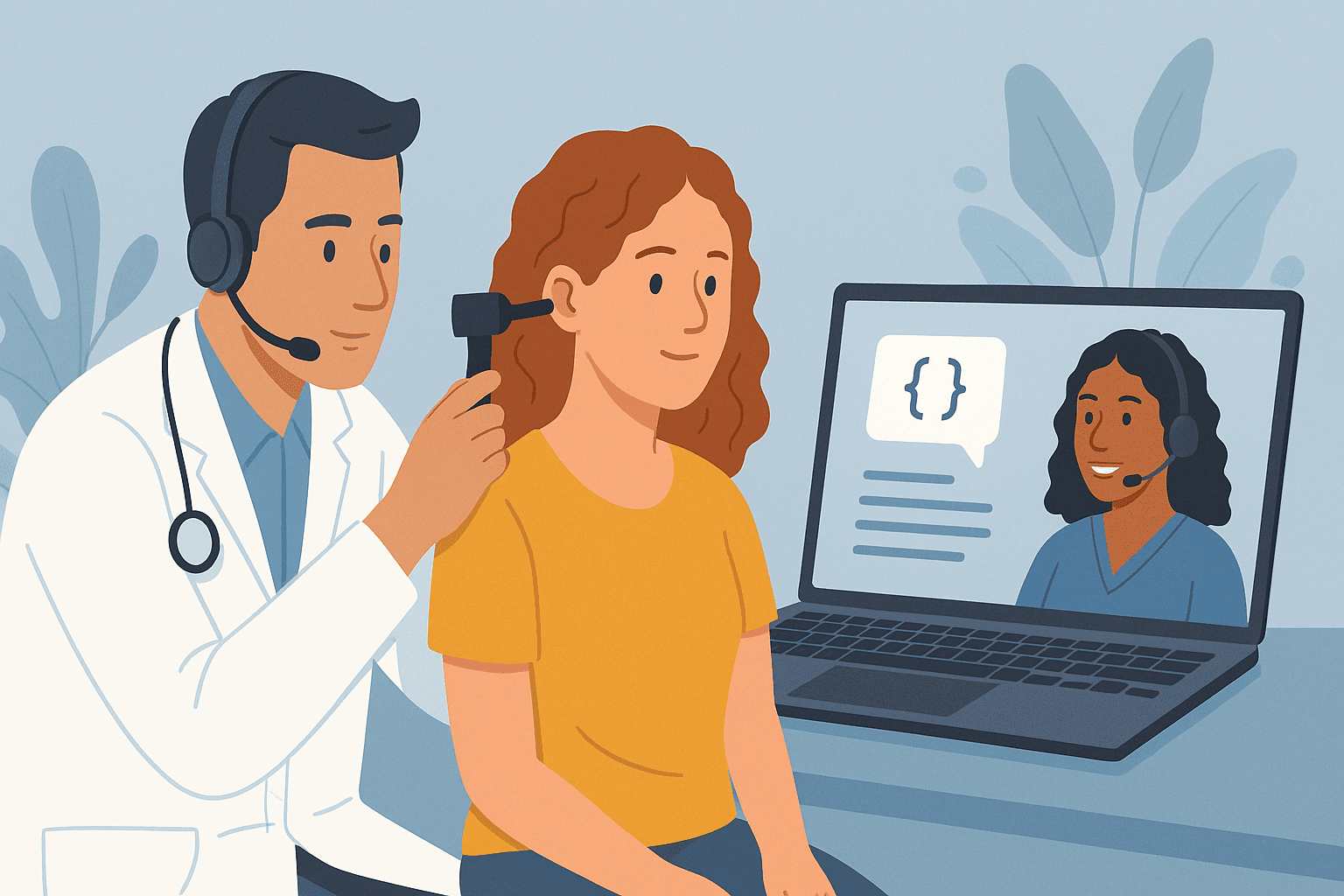Updated on: July 15, 2025
From seasonal sinus infections to complex laryngoscopies, ENT specialists manage a broad spectrum of conditions that require concise yet thorough notes. But keeping up with that documentation across outpatient visits, surgeries, and follow-ups can be overwhelming.
That’s why more otolaryngologists are turning to DocScrib, the AI medical scribe tailored for ENT workflows. It listens in real time and generates accurate, specialty-specific documentation—so you can focus on clinical care, not charting.
Why ENT Documentation Is Uniquely Challenging
A typical ENT consult includes:
-
Chief complaints: congestion, hearing loss, sore throat, dizziness, snoring
-
Physical exam: otoscopy, nasal endoscopy, laryngoscopy
-
Imaging: CT sinuses, audiograms, sleep studies
-
Surgical planning: FESS, septoplasty, tonsillectomy, thyroidectomy
-
Post-op care: packing changes, suture checks, infection surveillance
-
Medications: antibiotics, steroids, antihistamines, nasal sprays
-
Multi-system interaction: ears, nasal cavity, pharynx, larynx, head and neck
Every encounter requires precision and consistency—something that generic templates or voice notes can’t guarantee.
What Is an AI Medical Scribe for ENT?
DocScrib’s ENT scribe uses real-time speech recognition and medical AI to document encounters while you speak. It structures SOAP notes, procedure documentation, and follow-ups—all tuned to ENT workflows.
Whether you’re in clinic, performing in-office procedures, or reviewing test results, DocScrib captures your decision-making and exam findings instantly.
How DocScrib Works in ENT Practice
-
Start the visit
DocScrib listens securely in the background during in-person or telehealth sessions. -
Real-time interpretation
It understands ENT terminology—otoscopy findings, deviated septum, hoarseness, or vertigo. -
Generates structured notes
Full consults, follow-ups, and procedural notes are produced immediately. -
You review and sync to EMR
Approve the draft and push it to your record system in seconds.
Why ENT Specialists Trust DocScrib
🦻 Captures Ear-Specific Findings
Logs otoscopic findings like cerumen impaction, tympanic membrane status, or otitis media.
👃 Documents Nasal and Sinus Assessments
Recognizes descriptions of polyps, deviated septum, mucosal swelling, and CT sinus interpretations.
🗣️ Laryngoscopy & Voice Exam Summaries
Accurately records vocal cord findings, hoarseness, nodules, or reflux laryngitis.
🧠 Integrates Imaging and Labs
Automatically includes results from audiometry, CT, and sleep studies into your notes.
✂️ Pre- and Post-Op Surgical Templates
Built-in support for septoplasty, tonsillectomy, FESS, tympanoplasty, and more.
⏱️ Saves 1–2 Hours Daily
With notes completed before the next patient, evenings are yours again.
DocScrib Features Tailored for ENT
-
📝 ENT-Specific SOAP Templates
Designed for sinusitis, otitis, sleep apnea, vertigo, vocal disorders, and tinnitus. -
📸 Procedure Note Templates
Includes in-office procedures (e.g., nasal endoscopy, cerumen removal) and OR surgeries. -
🔊 Audiogram & Sleep Study Integrations
Captures interpretation and clinical implications in structured form. -
💊 Medication Documentation
Auto-inserts common ENT prescriptions with dose, frequency, and indication. -
🧑⚕️ Multi-System Support
Tracks symptom patterns across ENT regions over time.
Top ENT Use Cases for DocScrib
-
Sinusitis Follow-Ups: Exam findings, CT interpretation, med response
-
Otitis Media Visits: Otoscopy findings, hearing tests, antibiotic planning
-
Sleep Apnea Workups: Sleep study logs, CPAP discussion, weight/BMI notes
-
Voice Disorder Evaluations: Laryngoscopy results, vocal hygiene plans
-
Vertigo & Balance: Dix-Hallpike test, neurological assessment, referral tracking
-
Surgical Post-Ops: Suture checks, infection signs, recovery progress
Real-World Case Study: ENT Group in Florida
📍 5 ENT physicians + 3 audiologists
Results in 30 Days:
-
Reduced after-hours charting by 80%
-
Faster documentation for in-office nasal endoscopies
-
Improved surgical note consistency
-
Boosted patient throughput by 15%
💬 “DocScrib made my notes clearer and faster. I now finish charting during the visit, not hours later.”
DocScrib vs. Manual ENT Note-Taking
| Feature | Manual Notes | DocScrib AI Scribe |
|---|---|---|
| Otoscopy/Laryngoscopy Exams | Typed manually | ✅ Auto-inserted |
| Audiogram/Sleep Study Results | Must transcribe | ✅ Structured summaries |
| Procedure Documentation | Copy/paste templates | ✅ Built-in + editable |
| Medication Tracking | Easy to miss | ✅ Auto-filled with context |
| Time Per Patient Note | 10–15 minutes | ✅ Under 2 minutes |
FAQs: ENT + AI Medical Scribes
Q1. Can DocScrib capture in-office procedures like nasal endoscopy or cerumen removal?
Yes, we offer templated and customizable notes for ENT procedures—just review and approve.
Q2. Does it document physical exam findings like otoscopy and nasal inspection?
Absolutely. DocScrib listens to your clinical discussion and inserts detailed exam findings into your note.
Q3. Will it integrate sleep study or audiometry results?
Yes, you can speak test summaries aloud or integrate data sources—it will format them properly into the note.
Q4. Is this HIPAA-compliant and secure?
Yes. DocScrib is fully HIPAA-compliant, encrypted, and EMR-integrated.
Get Started with DocScrib for ENT Today
-
Book your free demo
-
Select “ENT” as your specialty
-
Customize your templates for sinus, voice, ear, or surgical workflows
-
Start saving hours every week
Conclusion: Voice-Driven Care. Keyboard-Free Notes.
ENT specialists deliver care across multiple systems—ear, nose, throat, sinuses, sleep—and your documentation should be as sharp as your clinical skills.
With DocScrib’s AI medical scribe for ENT, your notes are faster, more accurate, and easier to complete—without burnout or late nights.
🩺 Let your AI do the typing → Try DocScrib for ENT
